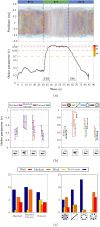Moving in unison after perceptual interruption
- PMID: 33093528
- PMCID: PMC7582161
- DOI: 10.1038/s41598-020-74914-z
Moving in unison after perceptual interruption
Abstract
Humans interact in groups through various perception and action channels. The continuity of interaction despite a transient loss of perceptual contact often exists and contributes to goal achievement. Here, we study the dynamics of this continuity, in two experiments involving groups of participants ([Formula: see text]) synchronizing their movements in space and in time. We show that behavioural unison can be maintained after perceptual contact has been lost, for about 7s. Agent similarity and spatial configuration in the group modulated synchronization performance, differently so when perceptual interaction was present or when it was memorized. Modelling these data through a network of oscillators enabled us to clarify the double origin of this memory effect, of individual and social nature. These results shed new light into why humans continue to move in unison after perceptual interruption, and are consequential for a wide variety of applications at work, in art and in sport.
Conflict of interest statement
The authors declare no competing interests.
Figures



References
-
- Kelso J, Scholz JP, Schöner G. Nonequilibrium phase transitions in coordinated biological motion: critical fluctuations. Phys. Lett. A. 1986;118:279–284. doi: 10.1016/0375-9601(86)90359-2. - DOI
-
- Strogatz S. Sync: The Emerging Science of Spontaneous Order. New York, NY: Penguin Group; 2004.
-
- Okugawa, Y., Kubo, M., Shimohagi, T., Ishihara, T. & Sato, H. Analysis of a parade with the kuramoto model-for better performance without trainings. In 2018 IEEE International Conference on Systems, Man, and Cybernetics (SMC), 4005–4010 (2018).
Publication types
MeSH terms
LinkOut - more resources
Full Text Sources
Medical

